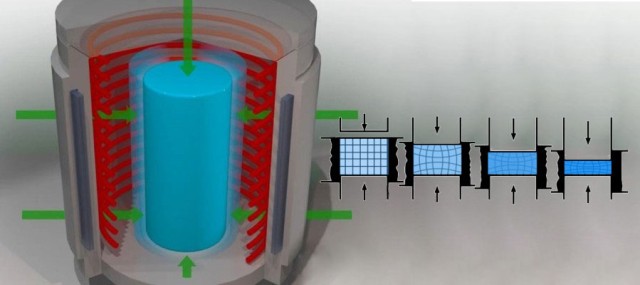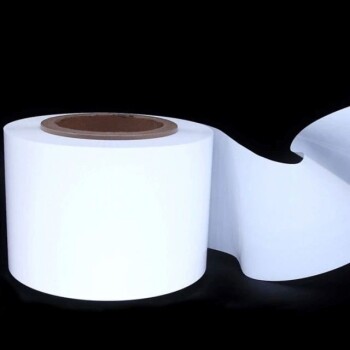Introduction to Isostatic Pressing
Pascal Principle and Its Application
In fluid statics, the Pascal principle elucidates how pressure is uniformly disseminated in all directions within an incompressible fluid. This principle serves as the bedrock for isostatic pressing technology, which leverages this uniform pressure distribution to achieve high-density and high-uniformity in molded materials.
The Pascal principle posits that any pressure applied to a confined fluid is transmitted without reduction to every point within the fluid and to the walls of the container. This concept is pivotal in isostatic pressing, where a powder is encased in a high-pressure container and subjected to uniform pressure from all directions via a liquid or gas medium. The result is a homogenous compaction of the material, yielding high-density and uniform blanks.
To illustrate, consider a typical isostatic pressing setup: a sealed chamber filled with a fluid medium, enclosing a powdered material. When pressure is applied to the fluid, it acts equally on all surfaces of the powder, compressing it uniformly. This uniform compression is what differentiates isostatic pressing from other molding techniques, ensuring that the final product has consistent properties throughout.
The application of the Pascal principle in isostatic pressing extends beyond just the initial compaction process. It also influences the subsequent stages of material processing, such as sintering and forging, by providing a strong and uniform 'green body' that can withstand these high-temperature and high-pressure treatments. This foundational understanding of fluid dynamics underpins the entire isostatic pressing process, making it a cornerstone of advanced material molding technologies.

Isostatic Pressing Process
Isostatic pressing is a sophisticated manufacturing technique that involves placing a powder material into a high-pressure container filled with a liquid or gas medium. This medium uniformly distributes pressure from all directions, ensuring that the workpiece experiences consistent compression. This method is particularly effective for achieving high-density and highly uniform blanks, which are essential for subsequent processing steps such as sintering or forging.
The process begins with the careful placement of the powder material within a sealed container. Once the container is sealed and filled with the pressurizing medium, high pressure is applied. This pressure is evenly transmitted through the medium, allowing for uniform compaction of the powder from every angle. The result is a dense, uniform structure that meets the stringent requirements for various industrial applications.
Over time, advancements in technology have expanded the use of isostatic presses across multiple industries. These presses are now widely employed in the formation of high-temperature refractory materials, ceramics, cemented carbides, lanthanon permanent magnets, carbon materials, and rare metal powders. Each of these materials benefits from the precise and uniform compaction provided by the isostatic pressing process, ensuring that the final products meet the high standards demanded by their respective applications.
Types of Isostatic Pressing
Cold Isostatic Pressing (CIP)
Cold Isostatic Pressing (CIP), also known as cold isostatic compaction, is a widely adopted technique in the manufacturing industry. This method operates at room temperature and employs high pressure, typically ranging from 100 to 630 MPa, to create a robust 'green body' suitable for subsequent sintering or forging processes. The essence of CIP lies in its ability to subject materials to uniform pressure from all directions, which is achieved by immersing the material in a high-pressure fluid medium, such as oil or water, and applying hydraulic pressure.
The process begins with the placement of powdered material within a mold made from elastomeric materials like urethane, rubber, or polyvinyl chloride. These molds are flexible, allowing for the formation of intricate shapes and achieving high green density. However, the flexibility of the mold can lead to issues with geometric accuracy, which is a known limitation of this process. Once the powder is compacted uniformly, the resulting green compact is typically subjected to conventional sintering to produce the final part.
CIP is particularly effective for shaping and consolidating powdered materials, making it ideal for laboratory preparation or small batch production due to its adaptability and cost-effectiveness in producing multiple blanks. The high pressures involved, often ranging from 400 MPa to 1000 MPa, ensure a uniform density across the material, which is crucial for the quality and consistency of the final product. Despite its advantages, the low geometric accuracy due to the flexible mold remains a challenge that manufacturers must address.
Warm Isostatic Pressing (WIP)
Warm isostatic pressing (WIP) is a specialized variant of cold isostatic pressing (CIP) that introduces a heating element to the process. Operating at temperatures typically below 500℃ and pressures reaching up to 300MPa, WIP is particularly advantageous for materials that cannot be effectively formed at room temperature. This includes polymers like polyamide and elastomers such as rubber, which require elevated temperatures to achieve their optimal mechanical properties.
Unlike traditional cold isostatic pressing, which relies solely on hydraulic pressure, WIP incorporates both pressure and low-temperature compaction, often up to 100°C. This dual approach ensures that the material is uniformly compacted from all directions, mitigating the dimensional inconsistencies that can arise from one-sided pressure applications. The pressing fluid, typically water, can be substituted with oil to better suit specific material requirements.
WIP's ability to apply equal and uniform pressure on all surfaces makes it a preferred method for manufacturers in the electronics industry, where precision and consistency are paramount. This technology enables the shaping and pressing of powder materials using flexible jacket molds and hydraulic pressure, facilitating the production of complex, high-density parts in a cost-effective manner.
Moreover, WIP represents a cutting-edge advancement in isostatic pressing technology, allowing for operations that do not exceed the boiling point of the liquid medium. This careful temperature control ensures that the integrity of the materials is maintained throughout the pressing process, making WIP an indispensable tool for achieving high-density molding in applications where traditional methods fall short.

Hot Isostatic Pressing (HIP)
Hot Isostatic Pressing (HIP) is a sophisticated densification method that employs high temperatures and pressures to achieve near-perfect densification and sintering of materials. The process typically operates within a temperature range of 1000-2200℃ and under pressures of 100-200MPa, making it a critical technique in the realm of advanced ceramics, metal alloys, and additive manufacturing.
The essence of HIP lies in its ability to apply uniform pressure from all directions using an inert gas, most commonly argon. This isostatic pressure ensures that the material undergoes consistent densification, regardless of its shape or complexity. The high temperatures and pressures work in tandem to eliminate defects such as porosity and microcracks, resulting in fully dense and mechanically robust components.
Key benefits of HIP include significant improvements in mechanical properties, such as enhanced fatigue resistance and improved surface finish. Additionally, the reliability and performance of critical parts are markedly increased, reducing the rejection rate in manufacturing processes. The flexibility in sample shape due to the isostatic nature of the pressurizing medium also means that surface preparation can be less stringent, streamlining the overall process.
In summary, HIP is a cornerstone technique for achieving high-density and high-performance components, particularly in industries that demand precision and reliability. Its ability to consolidate both metals and ceramics makes it an indispensable tool in modern manufacturing.
Applications and Considerations
Cold Isostatic Pressing Applications
Cold isostatic pressing (CIP) is a versatile and cost-effective method suitable for both laboratory preparation and small batch production. This technique excels in producing multiple blanks with uniform density and strength, making it ideal for materials that require precise handling and further processing.
Key Applications of Cold Isostatic Pressing
- Consolidation of Ceramic Powders: CIP is widely used to consolidate ceramic powders, ensuring uniform density and strength, which are crucial for subsequent sintering processes.
- Graphite and Refractory Materials: The technology is employed to produce high-quality graphite and refractory materials, enhancing their mechanical properties and corrosion resistance.
- Electrical Insulators: CIP ensures the uniform density and strength of electrical insulators, improving their performance and longevity in various applications.
- Advanced Ceramics: Materials such as silicon nitride, silicon carbide, and boron nitride benefit from CIP, achieving theoretical densities close to 100% for metals and about 95% for ceramics.
- Sputtering Targets: The expansion of CIP into new applications includes the compression of sputtering targets, which are essential in various industrial processes.
- Automotive and Aerospace: CIP is used to coat valve components, reducing cylinder wear and enhancing performance in engines, as well as in aerospace applications where material integrity is critical.
Advantages of Cold Isostatic Pressing
- Uniform Density: The uniform application of pressure ensures that materials have consistent density, leading to uniform shrinkage during sintering.
- Uniform Strength: Equal pressure in all directions results in materials with uniform strength, making them more efficient and reliable.
- Versatility: CIP can produce complex shapes and large-sized materials, limited only by the size of the pressure vessel.
- Corrosion Resistance: Improved corrosion resistance extends the lifespan of materials, making them suitable for harsh environments.
- Enhanced Mechanical Properties: Materials processed via CIP exhibit improved ductility and strength, meeting the demands of various industrial applications.
Cold isostatic pressing is a cornerstone in the production of high-quality materials, offering a robust solution for creating blanks that are ready for further sintering or hot isostatic pressing processes.
Warm Isostatic Pressing Applications
Warm isostatic pressing (WIP) has emerged as a pivotal technology in the manufacturing of electronic ceramic products, particularly for the lamination and densification of green bodies. Unlike traditional methods such as heated platen pressing, which often results in non-uniform pressure distribution, WIP ensures equal and uniform pressure on all surfaces, thereby minimizing dimensional variations.
The process involves heating a liquid medium, typically water or oil, to temperatures around 100°C before injecting it into a sealed pressing cylinder. This cylinder is equipped with a heating element to maintain precise temperature control, a critical aspect for achieving consistent results. The pressing fluid, whether water or oil, plays a crucial role in evenly distributing pressure, which is essential for the integrity and precision of the final product.

WIP is particularly advantageous for materials that have special temperature requirements or cannot be molded at room temperature. This includes various powders, binders, and other materials that benefit from controlled heating during the pressing process. The technology has revolutionized the electronics industry by enabling the production of complex parts and components with enhanced precision and efficiency.
In summary, while WIP presents challenges in precise temperature control, its ability to apply uniform pressure and handle materials with specific temperature needs makes it an indispensable tool in the production of high-quality electronic ceramic products.
Hot Isostatic Pressing Applications
Hot isostatic pressing (HIP) stands as a cornerstone in the densification and sintering of hard and brittle materials, such as advanced ceramics and cemented carbides, despite its significant energy consumption and cost. This process, akin to sintering but executed under much higher pressures, transforms these materials into fully dense, high-performance components. HIP's versatility extends across various industries, including aviation, tooling, healthcare, energy, automotive, military, oil and gas, electronics, and the semiconductor sector.
One of the primary advantages of HIP is its ability to reduce or eliminate voids within castings, which is crucial for enhancing material integrity and performance. Additionally, HIP facilitates the consolidation of encapsulated powders, creating materials with exceptional density and uniformity. This capability is particularly valuable in the production of components that demand high reliability and durability, such as those used in aerospace and medical devices.
Moreover, HIP enables the bonding of similar and dissimilar materials, allowing for the creation of unique, cost-effective components. This feature is instrumental in the development of complex parts that would otherwise be challenging or impossible to produce through conventional methods. The process's high temperatures and pressures ensure that these bonded materials achieve a strong, cohesive structure, suitable for demanding applications.
In summary, while HIP's energy-intensive nature and cost may be barriers for some, its unparalleled ability to enhance material properties and produce high-quality components makes it indispensable in numerous high-tech industries.
Related Products
- Isostatic Molding Pressing Molds for Lab
- Cold Isostatic Pressing Machine CIP for Small Workpiece Production 400Mpa
- Warm Isostatic Press WIP Workstation 300Mpa for High Pressure Applications
- Warm Isostatic Press for Solid State Battery Research
- Automatic Lab Cold Isostatic Press CIP Machine Cold Isostatic Pressing
Related Articles
- Zirconia Ceramic Rod Production Processes: Isostatic Pressing vs. Dry Pressing
- Isostatic Pressing Technology: Principles, Classification, and Applications
- Isostatic Pressing Technology: Revolutionizing Ceramic Material Densification
- The Benefits of Using Isostatic Pressing in Manufacturing
- Comprehensive Guide to Isostatic Pressing:Processes, and Features


















